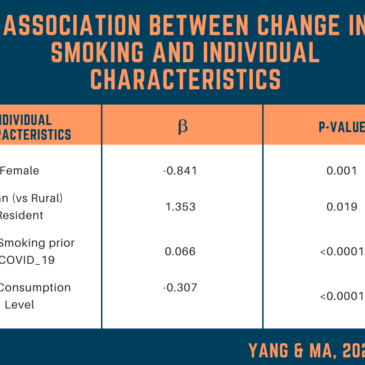COVID-19 is an infectious disease that primarily targets the respiratory system. Smoking tobacco is also harmful to the respiratory system. It is unclear how the pandemic has affected the prevalence of tobacco use and addiction — particularly for China, which has the highest number of smokers in the world. For example, lockdowns and movement restrictions may have reduced consumers’ access to tobacco products. On the other hand, the increased stress and negative emotions compounded with social distancing practices may lead to increased tobacco consumption. This week, ASHES reviews a study done by Haiyang Yang and Jingjing Ma that examined how tobacco consumption among Chinese adults has changed since the COVID-19 pandemic began.
What was the research question?
How has tobacco consumption among adults in China changed since the COVID-19 pandemic began?
What did the researchers do?
A random sample of 11,500 adults in China completed a questionnaire in October 2020, by which time the nationwide outbreak of COVID-19 in China had been contained. Participants self-reported their demographics (e.g., gender), how long they had been smoking (in years), quantity of cigarettes they smoked a day before the onset of the pandemic (i.e., prior consumption level), and the quantity of cigarettes they smoke currently. They also reported their current satisfaction with their physical health and emotional well-being.
To explore the changes in cigarette consumption from before the onset of the pandemic compared to October 2020, the researchers subtracted the quantity of cigarettes smoked per day pre-COVID-19 from the quantity of cigarettes smoked per day currently. To assess current emotional well-being, they subtracted the negative emotion measures from the positive emotion measures. They tested differences across the entire population, then conducted regression analyses to determine which smoker segments (e.g., gender, urban vs. rural) were most impacted.
What did they find?
Across the whole sample, there was an overall reduction in smoking from before the pandemic to after it was contained. More individuals quit smoking than started smoking during the pandemic, yielding a positive net change in smoking cessation. On average, smokers significantly reduced the quantity of cigarettes that they consumed daily after the pandemic was contained by -0.38 cigarettes per day. Female smokers were more likely than their male counterparts to have reduced their cigarette consumption. Those with a higher prior consumption level were also more likely to have reduced their smoking. In contrast, smokers who lived in urban areas were less likely to reduce their smoking than those who lived in rural areas. Those with a longer history of smoking were less likely to reduce their smoking as well (see Figure). Smokers who had reduced their smoking during the pandemic experienced higher satisfaction with their physical health as well as better emotional well-being.

Figure. The results of the regression analysis for change in smoking based off individual characteristics. A negative β (the standardized regression coefficient) indicates an association with a decrease in smoking, while the opposite indicates an association with an increase. All associations met the conventional level of statistical significance (i.e., p < 0.05). Click image to enlarge.
Why do these findings matter?
The research points out disparities in China when it comes to smoking reduction and cessation since the onset of a global pandemic. Health policies and programs related to tobacco reduction and cessation need to consider the greater vulnerabilities of males, those with longer histories of smoking, and those living in urban communities. The findings also highlight the physical and psychological benefits associated with overcoming tobacco addiction, so it is necessary to make sure that the most vulnerable populations are targeted and not left behind.
Every study has limitations. What are the limitations in this study?
The data were collected in October 2020 when the pandemic was contained in China (lockdown restrictions had been lifted in most provinces by April 2020), but outbreaks were still occurring. Considering this, it may have been too early to judge the long-term effects of the pandemic on smoking behavior. A follow-up study is needed to try to determine before-and-after effects of the pandemic. Secondly, the participants of this study self-reported the measures meaning there is higher potential of recall bias in the data. Lastly, this research was based on the adult population in China and therefore results may not be generalizable to other adults across the world.
For more information:
SmokeFree offers tools and tips for quitting and maintaining abstinence from smoking tobacco. The Centers for Disease Control and Prevention also provides research and tips about cigarettes and how to quit. For more details about addiction, visit our Addiction Resources page.
— Karen Amichia
What do you think? Please use the comment link below to provide feedback on this article.




